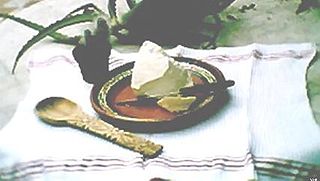
Tostada is a Spanish word meaning "toasted". In Mexico and other parts of Latin America, it is the name of various local dishes which are toasted or use a toasted ingredient as the main base of their preparation.
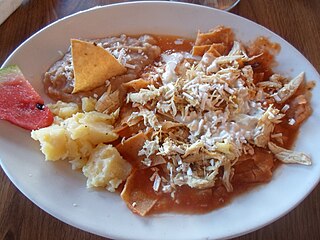
Chilaquiles from the Nahuatl word chīlāquilitl[t͡ʃiːlaːˈkilit͡ɬ] is a traditional Mexican dish.
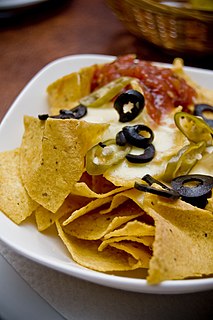
Nachos is a Mexican dish from northern Mexico that consists of heated tortilla chips or totopos covered with melted cheese, often served as a snack or appetizer. More elaborate versions of the dish add other ingredients, and may be substantial enough to serve as a main dish. Ignacio "Nacho" Anaya is credited with creating the dish around 1943; the original nachos consisted of fried corn tortilla chips covered with melted cheese and sliced jalapeño peppers.
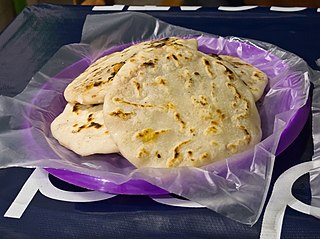
Salvadoran cuisine is a style of cooking derived from the nation of El Salvador. The traditional cuisine consists of food from Native American cuisine, indigenous Lenca, Pipil and European Spanish peoples. Many of the dishes are made with maize (corn).

Chicharrón is a dish generally consisting of fried pork belly or fried pork rinds. Chicharrón may also be made from chicken, mutton or beef.

The chile relleno is a dish in Mexican cuisine that originated in the city of Puebla.

New Mexican cuisine is the cuisine of the Southwestern US state of New Mexico, the region is primarily known for its fusion of Pueblo Native American with Hispano Spanish and Mexican cuisine originating in Nuevo México. This cuisine had adaptions and influences throughout its history, including early on from the nearby Apache, Navajo, and throughout New Spain and the Spanish Empire, also from French, Italian, Mediterranean, Portuguese cuisine, and European cafés, furthermore during the American territorial phase from cowboy chuckwagons and Western saloons, additionally after statehood from Route 66 American diners, fast food restaurants, and global cuisine. Even so, New Mexican cuisine developed in fairly isolated circumstances, which has allowed it to maintain its indigenous, Spanish, and Mexican identity, and is therefore not like any other Latin food originating in the contiguous United States.

Barcel is a maker of tortilla, potato chips and other confectionery and snack foods. It is a unit of Grupo Bimbo created in 1950. It is based in Lerma, State of Mexico, Mexico.
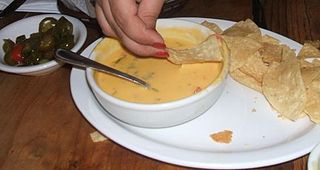
Chile con queso, sometimes described simply as queso, is an appetizer or side dish of melted cheese, or more usually, a pasteurised processed cheese food product such as Velveeta, and chili pepper typically served in Tex-Mex restaurants as a dip for tortilla chips.

Humita is a Native American dish from pre-Hispanic times, and a traditional food in Ecuador, Bolivia, Chile, although their origin is unclear. In Chile, they are known as humitas, in Bolivia as humintas, in Brazil as pamonha, and in Venezuela as hallaquitas. It consists of masa harina and corn, slowly steamed or boiled in a pot of water.

A mollete refers to an open-faced sandwich in Mexican cuisine or to a type of bread in Spanish cuisine.
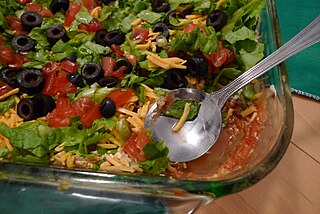
A seven-layer dip is an American appetizer based on ingredients typical of Tex-Mex cuisine. The first widely published recipe actually called it "Tex-Mex Dip" without reference to any layers. The dish was popular in Texas for some time before the recipe first appeared in print.

Stuffed peppers is a dish that exists in different names and forms around the world. It consists of hollowed or halved peppers, filled with any of a variety of fillings, often including meat, vegetables, cheese, rice, or sauce. They are usually assembled by filling the cavities of the peppers and then cooking.

Uruguayan cuisine is a fusion of cuisines from several European countries, with a particular emphasis on Mediterranean food from Spain, Italy, Portugal and France. Other possible influences on the cuisine may result from immigration from countries such as Germany and Britain. The food is very similar to Argentine cuisine. Uruguayan gastronomy is a result of immigration, rather than local Amerindian cuisine, because the new colonies did not trust the native Charrúa people. Spanish influences are very abundant: desserts like churros, flan, ensaimadas, and alfajores were all brought from Spain. There are also all kinds of stews known as guisos or estofados, arroces, and fabada. All of the guisos and traditional pucheros (stews) are also of Spanish origin. Uruguayan preparations of fish, such as dried salt cod (bacalao), calamari, and octopus, originate from the Basque and Galician regions, and also Portugal. Due to its strong Italian tradition, all of the famous Italian pasta dishes are present in Uruguay including ravioli, lasagne, tortellini, fettuccine, and the traditional gnocchi. Although the pasta can be served with many sauces, there is one special sauce that was created by Uruguayans. Caruso sauce is a pasta sauce made from double cream, meat, onions, ham and mushrooms. It is very popular with sorrentinos and agnolotti. Additionally, there is Germanic influence in Uruguayan cuisine as well, particularly in sweet dishes. The pastries known as bizcochos are Germanic in origin: croissants, known as medialunas, are the most popular of these, and can be found in two varieties: butter- and lard-based. Also German in origin are the Berlinese known as bolas de fraile, and the rolls called piononos. The facturas were re-christened with local names given the difficult German phonology, and usually Uruguayanized by the addition of a dulce de leche filling. Even dishes like chucrut (sauerkraut) have also made it into mainstream Uruguayan dishes.
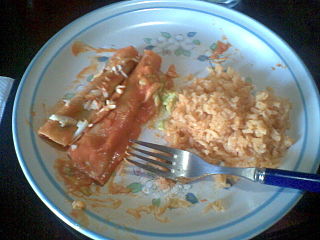
Entomatadas are a typical Mexican dish made of a folded corn tortilla which has first been fried in oil and then bathed in a tomato sauce made from tomatoes, garlic, onion, oregano, chile serrano (optional) and salt. The recipes for the tomato sauce vary by cook. The tortilla can be filled with a number of different ingredients, however the most common are chicken, beef, cheese or beans. The chicken and beef have most often been pressure cooked so that the meat is tender and can be pulled apart with the fingers. More tomato sauce is poured on top of the filled tortillas and the dish is garnished with sour cream, shredded cheese and slices of white onion.

Chilean gastronomy stems mainly from the combination of traditional Spanish cuisine, Chilean Indigenous Mapuche culture and local ingredients, with later important influences from other European cuisines, particularly from Germany, Italy and France. The food tradition and recipes in Chile are notable for the variety of flavours and ingredients, with the country’s diverse geography and climate hosting a wide range of agricultural produce, fruits and vegetables. The long coastline and the peoples' relationship with the Pacific Ocean add an immense array of seafood products to Chilean cuisine, with the country's waters home to unique species of fish, molluscs, crustaceans and algae, thanks to the oxygen-rich water carried in by the Humboldt Current. Chile is also one of the world’s largest producers of wine and many Chilean recipes are enhanced and accompanied by local wines.

Queso flameado is a dish of hot melted cheese and spicy chorizo that is often served flambé. Often compared to cheese fondue, it is a party dish; it is popular at cookouts and in restaurants as an appetizer. Almost unique in Mexican cuisine, in the cuisine of the United States this dish has been widely adapted and is considered a native dish in El Paso. In Mexico, it occurs in restaurants more often in the north. Typical main ingredients are melted cheese and a characteristic meat sauce of loose fresh chorizo, tomato, onion, chile and spices. It is served in a small, shallow casserole or other ceramic or metal heat-proof baking dish. The cheese and sauce are prepared separately, and combined just before serving. This may be done at the table, especially if finished with a flambé: high alcohol liquor is poured on the cheese and ignited, and as it burns the server folds in the sauce. If not flambéed, the mixture may be quickly broiled. Either way, the finished dish is presented while it is still bubbling hot, and it is spooned onto small soft tortillas for individual servings.
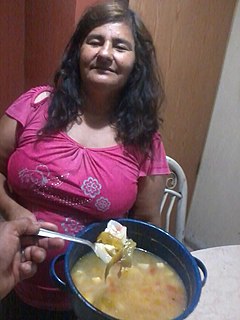
Caldo de queso is a traditional queso (cheese) soup made in places in Hermosillo, Sonora.
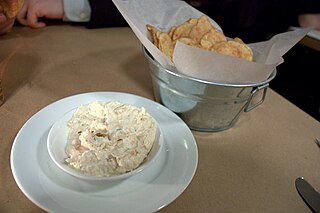
Chips and dip are a dish consisting of chips or crisps served with dips. Chips used include potato chips, tortilla chips, corn chips, bean chips, vegetable chips, pita chips, plantain chips and others. Crackers are also sometimes used, as are crudités, which are whole or sliced raw vegetables. Various types of dips are used to accompany various types of chips.
Del Castillo, María. (1966). Cocina mexicana. Ed. Olimpo.


